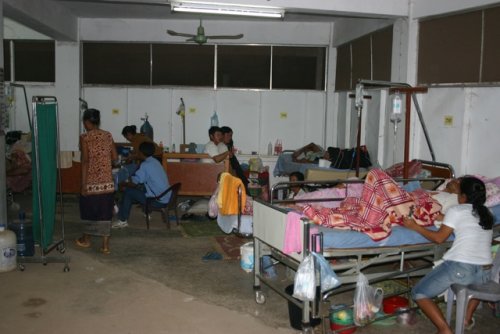Journey Through Laos: Where Are All the Doctors?
“There was an outbreak of typhoid and there were no health workers so no one identified it for three months and it spread to other villages. Eight people died.”
I’m in Laos, South East Asia, hearing about the impact of the lack of health workers in Laos from Health Poverty Action’s Country Director Bangyuan Wang. It’s grim listening.
Experts across the world are warning that unless we act now, a billion people will never see a health worker in their entire life. And as is common with global crises, it is the people living in poor countries that will feel it the hardest. Health Poverty Action and other organisations are working to address this crisis, but it is only as I travel through Laos, talking to people who work in health and meeting people who could be one of those billion, that I see what this figure really means.
I hear about a mother and father who travelled to a health centre with their sick child only to find it empty, and watch their child die; about women in labour who make it to the nearest health centre, find no one there and embark on the journey to the provincial hospital, but never make it.
I’m told that in Attapeu province, where Health Poverty Action works, there is not a single doctor. I look up the population of Attapeu: 114,300, a similar number of people as Winchester or Preston in the UK. It’s hard to imagine the people of Preston putting up with no doctor, yet ironically some of the health workers missing from low-income countries may well be in Preston.
The health staff deficit in many nations is in part fuelled by the migration of health workers from low to high-income countries. When they have a health worker shortage, many wealthy countries actively recruit internationally trained staff, and benefit from avoiding the cost of training. Though the UK has had a Code of Practice on the international recruitment of health workers in place since 2001 it does not cover the private sector, and of all the countries in Europe the UK has still received the most internationally trained doctors and nurses. ‘Benefitting’ may be putting it lightly.
The scale of this problem is so great that for some countries it is thought that the money they lose from health worker migration may be more than they receive in aid for health, leading to the situation being dubbed ‘reverse aid’. Some experts are now suggesting that this skills ‘debt’ means destination countries should be paying compensation to the low-income countries that lose their workforce.
The minimum number of health workers required for an adequate system is 23 doctors, nurses and midwives per 10,000 people, according to The World Health Organization (WHO). The world is currently 7.2 million health workers short of this and by 2035 the gap will be 12.9 million. Europe alone is predicted to have a shortfall of two million health workers by 2020; a situation to the detriment of Europeans and also to those in the Majority World, as it is likely to increase demand and leave low-income countries even more vulnerable to losing their already meagre workforce.
This crisis has the potential to impact every aspect of development. The WHO is calling it ‘one of the most critical constraints to the achievement of health and development goals‘, and yet governments are not acting. The issue is not currently receiving the political attention needed to avert catastrophe, and the consequences will be devastating.
Source: huffingtonpost

